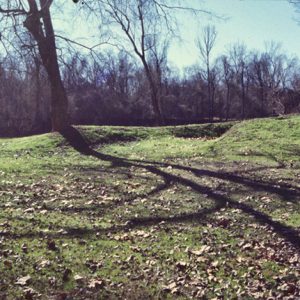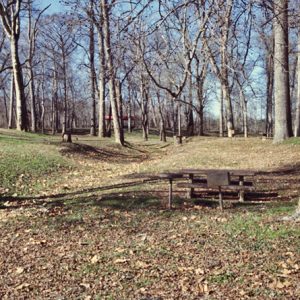calsfoundation@cals.org
Camden Water Battery
The Camden Water Battery was part of a system of Civil War fortifications that Confederate soldiers built in late 1864 to protect the city of Camden (Ouachita County) and block any Union movements toward Shreveport, Louisiana.
In mid-September 1864, Major General Sterling Price led a force of 12,000 Confederate men—including most of the cavalry serving in the state—on a raid into Missouri, which left only a few infantry divisions around Washington (Hempstead County) to defend southern Arkansas. Those troops were under the command of Major General John Bankhead “Prince John” Magruder, who faced the challenge of defending southwestern Arkansas as aggressive Federal patrols probed the region in the absence of Price and the Confederate cavalry.
Magruder’s ability to defend the region was further complicated by a lack of labor—particularly slave labor—to construct fortifications as Arkansans took their human property to refuge in Texas, where there was less chance of their escaping to Union lines or being freed by Yankee patrols. “I am told that over 150,000 negroes have gone from Missouri and Arkansas into Texas, and leaving out all considerations of fairness, I fear that if the few that remain here are impressed, those who would otherwise sow and plant would emigrate to Texas, and through the depopulation of the country we should not be able to support an army through another season,” Magruder wrote in a November 5, 1864, letter to Confederate Senator Robert W. Johnson. “I am the only officer I know of in the Trans-Mississippi Department who causes his troops to labor on fortifications.”
Magruder recognized the need for fortifications on the Little Missouri and Ouachita rivers. Strategically, the general saw that holding the line of the Ouachita was essential to the defense of the Red River, and he would make efforts to establish supply depots for Confederate troops in that area. He also applied to have slaves sent from the District of Texas to construct fortifications on the Ouachita and Little Missouri, contending that Confederate law allowed him to impress only eighty-five local slaves as laborers and that calling others into forced labor would lead their owners to flee to Texas.
In the fall of 1864, much of the infantry in Arkansas was ordered to move to Camden to protect the approaches to Texas during Price’s absence. Joseph Blessington, who served in Major General John Horace Forney’s division, wrote in his diary on October 6 that “at dress-parade, in the evening, we were ordered to be ready to commence fortifying the following morning. Our division was assigned the duty of fortifying the water-front of Camden; Parsons’s the south-east; Polginac’s the south-west; and Churchill’s, the north-west lines.”
The new fortifications would augment fieldworks that had already been built in Camden after Union forces occupied Little Rock (Pulaski County) in September 1863. Brigadier General Alexander T. Hawthorn directed construction of a network of rifle pits and gun emplacements at several strategic locations around the town, and a series of strong points was built between January and March 1864.
It is possible that the men of Forney’s division and their Confederate counterparts were set to work in part just to keep them occupied. As Magruder wrote on October 29, 1864, “I have to state that no extensive earthworks have been undertaken at Camden. I found it already fortified, and little else is being done than to connect detached works by rifle pits.” Construction was completed by November 13, and Magruder ordered Forney to move his division to the Spring Hill (Hempstead County) area, adding that “it would be well to place the artillery as near Dooley’s Ferry, on Red River, as possible.” The Texans were later moved to winter camps in Louisiana.
The Camden Water Battery was listed on the National Register of Historic Places on May 30, 2007.
For additional information:
Blessington, J. P. The Campaigns of Walker’s Texas Division. Austin, TX: State House Press, 1994.
“Camden Water Battery.” National Register of Historic Places nomination form. On file at Arkansas Historic Preservation Program, Little Rock, Arkansas.
Lowe, Richard. Walker’s Texas Division, C.S.A. Greyhounds of the Trans-Mississippi. Baton Rouge: Louisiana State University Press, 2004.
Moneyhon, Carl. “1865: A State of Perfect Anarchy.” In Rugged and Sublime: The Civil War in Arkansas, edited by Mark K. Christ. Fayetteville: University of Arkansas Press, 1994.
Shea, William. “The Camden Fortifications.” Arkansas Historical Quarterly 41 (Winter 1982): 319–326.
Mark K. Christ
Arkansas Historic Preservation Program



 Camden Water Battery
Camden Water Battery  Camden Water Battery
Camden Water Battery 



Comments
No comments on this entry yet.